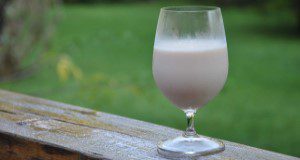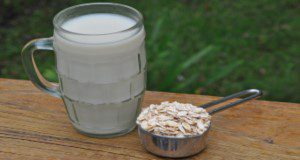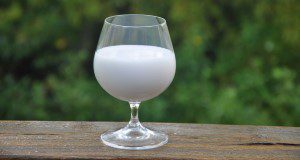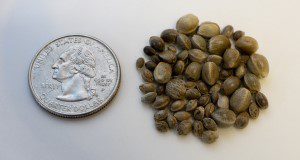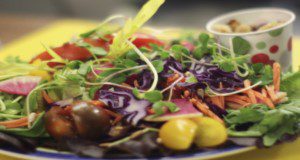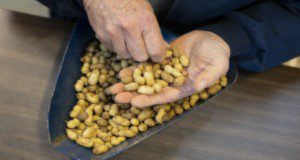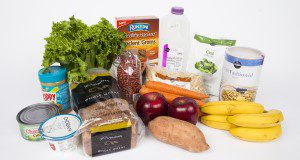La leche de soja es una leche vegetal elaborada a partir de semillas de soja (Glicine max). A diferencia de algunas de las leches de origen vegetal que se comercializan recientemente, la leche de soja tiene una larga historia como bebida en todo el mundo y se comercializa en los Estados Unidos durante más de un siglo. Si se ha preguntado cómo se compara con la leche de vaca, esta publicación describe los ingredientes y el contenido de nutrientes de la leche de soja producida comercialmente y sus posibles beneficios y riesgos para la salud.
This new 6-page publication of the UF/IFAS Food Science and Human Nutrition Department is the Spanish translation of FSHN20-54/FS422, Plant-Based Milks: Soy, written by Jessica Goldberg, Daniela Rivero-Mendoza, and Wendy J. Dahl.
https://edis.ifas.ufl.edu/fs430
Tag: Daniela Rivero Mendoza
Leches a base de plantas: Arroz
La leche de arroz es una bebida no láctea a base de plantas elaborada principalmente con arroz molido y agua. Se comercializa como un sustituto vegano de la leche de vaca, fácil de digerir y apto para personas alérgicas. Al igual que otras bebidas a base de plantas, la leche de arroz generalmente tiene un color blanco opaco o beige y una textura cremosa que se asemeja a la leche de vaca. Esta publicación describe cómo se elabora la leche de arroz, sus ingredientes y perfil de nutrientes, y los posibles beneficios para la salud y riesgos del consumo.
This new 5-page publication of the UF/IFAS Food Science and Human Nutrition Department is the Spanish translation of FSHN20-50/FS412, Plant-Based Milks: Rice, written by Meagan Lamothe, Daniela Rivero-Mendoza, and Wendy J. Dahl.
https://edis.ifas.ufl.edu/fs428
Leches a base de plantas: Avena
La leche de avena es una de las alternativas lácteas más recientes en llegar a los estantes de los supermercados, y actualmente hay varias marcas disponibles en los Estados Unidos. La leche de avena está hecha de avena en grano. Esta publicación describe cómo se elabora la leche de avena, sus ingredientes y perfil de nutrientes, y los posibles beneficios y riesgos para la salud del consumo.
This new 4-page publication of the UF/IFAS Food Science and Human Nutrition Department is the Spanish translation of FSHN20-52/FS419, Plant-Based Milks: Oat, written by Hannah Cooper, Daniela Rivero-Mendoza, and Wendy J. Dahl.
https://edis.ifas.ufl.edu/fs427
Leches a base de plantas: Almendras
La leche de almendras, una alternativa a la leche de origen vegetal, se produce a partir de almendras y agua. La leche de almendras tiene su origen en la región mediterránea y se consume desde hace muchos años. En los Estados Unidos, hay varias marcas comercializadas de leche de almendras. Esta publicación describe el perfil de nutrientes y los posibles beneficios y riesgos para la salud de la leche de almendras.
This new 3-page publication of the UF/IFAS Food Science and Human Nutrition Department is the Spanish version of FSHN20-48/FS410, Plant-Based Milks: Almond. Written by Elena Torna, Daniela Rivero Mendoza, and Wendy J. Dahl.
https://edis.ifas.ufl.edu/fs423
Plant-Based Milks: Soy
Soy milk is a plant-based milk made from the legume soybean. Unlike some of the recently marketed plant-based milks, soy milk has a long history as a beverage around the world and has been marketed in the United States for more than a century. If you have wondered how it compares to cow’s milk, this new 5-page publication of the UF/IFAS Food Science and Human Nutrition Department describes the composition and nutrient content of soy milk and its potential benefits and risks to health. Written by Jessica Goldberg, Daniela Rivero-Mendoza, and Wendy J. Dahl.
https://edis.ifas.ufl.edu/fs422
Leches a base de plantas: Coco
La leche de coco es una de las muchas variedades de alternativas vegetales a la leche de vaca. Los factores que pueden llevar a los consumidores hacia alternativas a la leche no láctea incluyen la adherencia a una dieta vegana, la intolerancia a la lactosa, la alergia a la leche de vaca o simplemente la preferencia. El propósito de esta guía es informarle sobre el contenido de nutrientes de la leche de coco y sus posibles beneficios y riesgos para la salud.
This new 4-page article is the Spanish language version of FSHN20-49/FS411, Plant-Based Milks: Coconut, written by Celia Andreo, Daniela Rivero-Mendoza, and Wendy J Dahl, and published by the UF/IFAS Food Science and Human Nutrition Department.
https://edis.ifas.ufl.edu/fs421
Nutricion para la salud y el estado fisico: azucar y otros edulcorantes
Esta publicación proporciona información sobre azúcares y otros edulcorantes en la dieta estadounidense. La publicación describe fuentes ocultas de azúcares agregados en los alimentos para ayudar a aquellos que desean reducir la ingesta de azúcar, a encontrar los azúcares agregados en sus dietas. La sección sobre edulcorantes de alta intensidad analiza las características de cada edulcorante aprobado.
This is the Spanish translation of FSHN20-46/FS406, Nutrition for Health and Fitness: Sugar and Other Sweeteners. Written by Wendy Dahl and Linda Bobroff, translated by Daniela Rivero-Mendoza, and published by the UF/IFAS Food Science and Human Nutrition Department.
https://edis.ifas.ufl.edu/fs407
Plant-Based Milks: Hemp
Hemp milk is a plant-based milk growing in popularity. Commercial hemp seed, used in the production of hemp milk, contains only trace amounts of the compound tetrahydrocannabinol (THC), much too low to produce any psychoactive effects from consuming the milk. This new 4-page publication describes the composition of hemp milk and the potential health benefits and risks. Written by Sarah Curl, Daniela Rivero-Mendoza, and Wendy J. Dahl, and published by the UF/IFAS Food Science and Human Nutrition Department.
https://edis.ifas.ufl.edu/fs420
Plant-Based Milks: Oat
Oat milk is one of the more recent dairy alternatives to hit the grocery shelves, and several brands are currently available in the United States. Oat milk is made from the cereal grain oats. This new 3-page publication of the UF/IFAS Food Science and Human Nutrition Department describes how oat milk is made, its ingredients and nutrient profile, and the potential health benefits and risks of consumption. Written by Hannah Cooper, Daniela Rivero-Mendoza, and Wendy J. Dahl.
https://edis.ifas.ufl.edu/fs419
Leches a base de plantas: Nuez de marañón (anacardo)
La disponibilidad y el consumo de alternativas de leche a base de plantas, también conocidas como no lácteas, han ido en aumento. Las ventas de alternativas a la leche no láctea se han más que duplicado, mientras que el consumo de leche de vaca tradicional ha disminuido. Este aumento puede deberse a que las leches de origen vegetal se perciben como “naturales”, así como a un aumento del veganismo y la búsqueda de evitar la lactosa. Las principales alternativas de leche de origen vegetal son la almendra, la soja, el coco, la nuez de marañón (anacardo) y el arroz. Esta publicación analiza el contenido nutricional, los posibles beneficios para la salud y los posibles riesgos de la leche de nuez de marañón.
This new 4-page article is the Spanish translation of FSHN20-51/FS413, Plant-Based Milks: Cashew, written by Jamie Zeldman, Daniela Rivero-Mendoza, and Wendy J. Dahl, translated by Daniela Rivero-Mendoza, and published by the UF/IFAS Food Science and Human Nutrition Department.
https://edis.ifas.ufl.edu/fs418
Dietas populares: Ayuno intermitente
La pérdida de peso puede ser un desafío. Comenzar una dieta restrictiva puede ser agotador emocionalmente y difícil de cumplir. ¿Hay alguna forma más efectiva de perder peso? ¿El momento y la frecuencia de las comidas ayudan a perder peso? Esta publicación describe los beneficios y riesgos del ayuno intermitente para bajar de peso.
This new 4-page article is the Spanish language translation of FSHN20-47/FS409, Popular Diets: Intermittent Fasting, written by Michelle Yavelow, Daniela Rivero-Mendoza, and Wendy Dahl, translated by Daniela Rivero-Mendoza, and published by the UF/IFAS Food Science and Human Nutrition Department.
https://edis.ifas.ufl.edu/fs417
Dietas populares: Alimentos crudos
La dieta de alimentos crudos tiene sus raíces en un movimiento vegetariano que se remonta a los años 1800. Como su nombre lo indica, una dieta de alimentos crudos es un patrón dietético compuesto mayoritaria o completamente por alimentos crudos y sin procesar. Esta publicación explora los posibles beneficios y riesgos para la salud de una dieta de alimentos crudos.
This is the Spanish translation of FSHN20-45/FS404, Popular Diets: Raw Foods, written by Alexa Barad, Daniela Rivero-Mendoza, and Wendy Dahl, translated by Daniela Rivero-Mendoza, and published by the UF/IFAS Food Science and Human Nutrition Department.
https://edis.ifas.ufl.edu/fs415
Pérdida de peso y los adultos mayores: Riesgos y beneficios
A los adultos obesos a menudo se les aconseja perder peso para reducir el riesgo de enfermedades crónicas. Sin embargo, los beneficios para la salud de la pérdida de peso cambian a medida que envejecemos. Esta publicación analiza los riesgos y beneficios de la pérdida de peso planificada y no planificada para adultos mayores.
This is the Spanish translation of FSHN20-42/FS401, Weight Loss and the Older Adult: Risks and Benefits, written by Wendy Gans, Rachelle Savelle, Nancy Gal, and Wendy Dahl, translated by Daniela Rivero-Mendoza, and published by the UF/IFAS Food Science and Human Nutrition Department.
https://edis.ifas.ufl.edu/fs414
Dietas populares: Dieta cetogénica
La dieta cetogénica es una dieta alta en grasas y muy baja en carbohidratos. El primer uso documentado de la dieta cetogénica fue en 1921 para tratar la epilepsia en niños. En los últimos años, la dieta cetogénica ha ganado un resurgimiento como un medio potencial para perder peso. La dieta cetogénica se ha vuelto popular debido al respaldo de las celebridades y las influencias de las redes sociales, pero ¿es segura y efectiva?
This new 4-page article is the Spanish translation of FSHN20-44/FS403, Popular Diets: Ketogenic Diet. Written by Kelsey Gemmill, Daniela Rivero-Mendoza, and Wendy Dahl, and published by the UF/IFAS Food Science and Human Nutrition Department.
https://edis.ifas.ufl.edu/fs416
Plant-Based Milks: Coconut
Plant-based alternatives to cow’s milk have become a rising trend. Factors that may steer consumers toward nondairy milk alternatives include adherence to a vegan diet, lactose intolerance, allergy to cow’s milk, or simply preference. Coconut milk is one of the many varieties of plant-based milk. Whether you are considered switching to or have already begun purchasing a plant-based milk, the purpose of this new 4-page guide is to inform you on the nutrient content of coconut milk and its potential health benefits and risks. Written by Celia Andreo, Daniela Rivero-Mendoza, and Wendy J. Dahl, and published by the UF/IFAS Food Science and Human Nutrition Department.
https://edis.ifas.ufl.edu/fs411
Plant-Based Milks: Almond
Almond milk, a plant-based milk alternative, is produced from almonds and water. Almond milk originated from the Mediterranean region and has been consumed for many years. In the United States, there are several marketed brands of almond milk. This new 3-page publication of the UF/IFAS Food Science and Human Nutrition Department describes the nutrient profile and potential health benefits and risks of almond milk. Written by Elena Torna, Daniela Rivero Mendoza, and Wendy J. Dahl.
https://edis.ifas.ufl.edu/fs410
Plant-Based Milks: Rice
Rice milk is a plant-based, nondairy beverage made primarily from milled rice and water. It is marketed as an allergy-friendly, easy-to-digest, vegan substitute for cow’s milk. Similar to other plant-based beverages, rice milk usually has an opaque white or beige color and creamy texture resembling that of cow’s milk. This new 4-page publication of the UF/IFAS Food Science and Human Nutrition Department describes how rice milk is made, its ingredients and nutrient profile, and potential health benefits and risks of consumption. Written by Meagan Lamothe, Daniela Rivero-Mendoza, and Wendy J. Dahl.
https://edis.ifas.ufl.edu/fs412
Popular Diets: Intermittent Fasting
Weight loss can be challenging. Starting a restrictive diet can be emotionally draining and difficult to adhere to. Is there a more effective way to lose weight? Does the timing and frequency of meals help to lose weight? This new 4-page publication of the UF/IFAS Food Science and Human Nutrition Department describes the benefits and risks of intermittent fasting for weight loss. Written by Michelle Yavelow, Daniela Rivero Mendoza, and Wendy Dahl.
https://edis.ifas.ufl.edu/fs409
Dieta e inflamación crónica
La inflamación es la respuesta de su cuerpo a las lesiones e infecciones—así es como su sistema inmunológico ayuda a protegerlo de cualquier daño. Por el contrario, la inflamación crónica contribuye a muchas enfermedades, como enfermedades cardíacas, diabetes y enfermedades renales y hepáticas. Esta publicación discute la inflamación y las opciones alimentarias que pueden ayudar a reducir la inflamación crónica.
This is the Spanish translation of FSHN20-43, Diet and Chronic Inflammation. Written by Daniela Rivero-Mendoza and Wendy Dahl, translated by Daniela Rivero-Mendoza, and published by the UF/IFAS Food Science and Human Nutrition Department.
https://edis.ifas.ufl.edu/fs405
Diet and Chronic Inflammation
Inflammation is your body’s response to injury and infection—it’s how your immune system helps to protect you from harm. In contrast, chronic inflammation contributes to many diseases, including heart disease, diabetes, and kidney and liver disease. This new 4-page publication of the UF/IFAS Food Science and Human Nutrition Department discusses inflammation and the dietary choices that may help to reduce chronic inflammation. Written by Daniela Rivero-Mendoza and Wendy Dahl.
https://edis.ifas.ufl.edu/fs402
